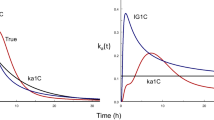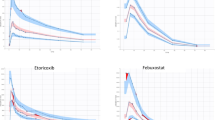Abstract
After administering a single 300 mg dose of theophylline in oral solution to 12 healthy adults, the dose-normalized area under the plasma concentration-time curve was 97.2±20.1 % (mean±SD) of that after giving a 500 mg dose and statistically indistinguishable. Similarly, these areas multiplied by the individual's terminal disposition rate constant (β) were statistically indistinguishable between 300 and 500mg doses (99.1±10.3%), giving no evidence of dose-dependence for theophylline kinetics at the levels below 15 μg/ml observed in these individuals. After an intravenous dose, a shortlived distribution phase (t1/2α) is sometimes seen. An a phase, however, is hardly discernible in over 250 profiles arising from oral doses administered during five single dose bioavailability studies. Almost all such profiles appear to follow single-compartment model predictions. With precautions to avoid a potential a phase, a terminal log-linear slope can be fitted by least squares analysis with a relative standard error in the slope determination almost always less than 6%. Covariance analysis confirms statistically that 39 of the 60 participating individuals varied in their β on the different occasions each was required to take a dose during the course of a crossover bioavailability trial. In one study, even though each individual was observed on only two occasions, 9 out of 12 showed statistically identifiable variation in β. Fluctuations in β of 60% can be seen. Changes of 30% or greater are common and can occur within 3 or 4 days. Thus real, large, and potentially frequent changes in β of theophylline have been identified in a majority of normal subjects. These changes do not appear to be confined to either sex, to smokers or nonsmokers, or to heavier or lighter individuals. No chronological pattern has, as yet, been recognized in the intraindividual variability in β.
Similar content being viewed by others
References
R. I. Ogilvie. Clinical pharmacokinetics of theophylline.Clin. Pharmacokin. 3:267–293 (1978).
L. Hendeles, M. Weinberger, and G. Johnson. Monitoring serum theophylline levels.Clin. Pharmacokin. 3:294–312 (1978).
C. W. Bierman. Theophylline in asthma.Pediatrics 58:623–635 (1976).
M. H. Jacobs, R. M. Senior, and G. Kessler. Clinical experience with theophylline: relationship between dosage, serum levels and toxicity.JAMA 235:1983–1986 (1976).
C. W. Zwillich, F. D. Sutton, T. A. Neff, W. M. Cohn, R. A. Matthar, and M. M. Weinberger. Theophylline induced seizures in adults.Ann. Br. Med. 82:784–787 (1975).
P. R. Yarnell and N-S. Chu. Focal seizures and aminophylline.Neurology 25:819–822 (1975).
E. F. Ellis, R. Koysooko, and G. Levy. Pharmacokinetics of theophylline in children with asthma.Pediatrics 58:542–547 (1976).
J. W. Jenne, E. Wyse, F. S. Rood, and F. M. McDonald. Pharmacokinetics of theophylline: application to adjustment of the clinical dose of aminophylline.Clin. Pharmacol. Ther. 13:349–360 (1972).
J. R. Powell, S. Vozeh, P. Hopewell, J. Costello, L. B. Sheiner, and S. Riegelman. Theophylline disposition in acutely ill hospitalized patients. The effect of smoking, heart failure, severe airways obstruction and pneumonia.Am. Rev. Resp. Dis. 118:229–238 (1978).
P. D. Walson, R. C. Strunk, and L. M. Taussig. Intrapatient variability in theophylline kinetics,J. Pediatr. 91:321–324 (1977).
P. Leung, A. Kalisker, and T. D. Bell. Variation in theophylline clearance with time in chronic childhood asthma.J. Allergy Clin. Immunol. 59:440–444 (1977).
J. G. Wagner. Method of estimating relative absorption of a drug in a series of clinical studies in which blood levels are measured after single and/or multiple doses.J. Pharm. Sci. 56:652–653 (1967).
R. A. Upton, S. Riegelman, and L. B. Sheiner. Bioavailability assessment as influenced by variation in drug disposition. In K. S. Albert (ed.),Drug Absorption and Disposition: Statistical Considerations. American Pharmaceutical Association Academy of Pharmaceutical Sciences, Washington, D.C., 1980, pp. 77–85.
R. A. Upton, J-F. Thiercelin, J. K. Moore, and S. Riegelman. A method of estimating within-individual variability in clearance and in volume of distribution from standard bioavailability studies.J. Pharmacokin. Biopharm. 10:135–146 (1982).
R. A. Upton, L. Sansom, T. W. Guentert, J. R. Powell, J-F. Thiercelin, V. P. Shah, P. E. Coates, and S. Riegelman. Evaluation of the absorption from 15 commercial theophylline products indicating deficiencies in currently applied bioavailability criteria.J. Pharmacokin. Biopharm. 8:229–242 (1980).
J. H. Zar.Biostatistical Analysis. Prentice-Hall, Englewood Cliffs, N.J., 1974, pp. 230ff.
J. G. Wagner. Intrasubject variation in elimination half-lives of drugs which are appreciably metabolized.J. Pharmacokin. Biopharm. 1:165–173 (1973).
K. C. Yeh and K. C. Kwan. A comparison of numerical integrating algorithms by trapezoidal, Lagrange and spline approximation.J. Pharmacokin. Biopharm. 6:79–98 (1978).
W. L. Chiou. Critical evaluation of the potential error in pharmacokinetic studies of using the linear trapezoidal rule method for the calculation of the area under the plasma level-time curve.J. Pharmacokin. Biopharm. 6:539–546 (1978).
D. D-S. Tang-Liu, T. N. Tozer, and S. Riegelman. Urine flow dependence of theophylline renal clearance in man.J. Pharmacokin. Biopharm. In press (1982).
T. J. Monks, J. Caldwell, and R. L. Smith. Influence of methylxanthine-containing foods on theophylline metabolism and kinetics.Clin. Pharmcol. Ther. 26:513–524 (1979).
W. J. Jusko, J. J. Schentag, J. H. Clark, M. Gardner, and A. M. Yuschak. Enhanced biotransformation of theophylline in marijuana and tobacco smokers.Clin. Pharmacol. Ther. 24:406–410 (1978).
A. Kappas, K. E. Anderson, A. H. Conney, and A. P. Alvares. Influence of dietary protein and carbohydrate on antipyrine and theophylline metabolism in man.Clin. Pharmacol. Ther. 20:643–653 (1977).
Author information
Authors and Affiliations
Additional information
Deceased, April 4th, 1981.
Rights and permissions
About this article
Cite this article
Upton, R.A., Thiercelin, JF., Guentert, T.W. et al. Intraindividual variability in theophylline pharmacokinetics: Statistical verification in 39 of 60 healthy young adults. Journal of Pharmacokinetics and Biopharmaceutics 10, 123–134 (1982). https://doi.org/10.1007/BF01062330
Received:
Revised:
Published:
Issue Date:
DOI: https://doi.org/10.1007/BF01062330




